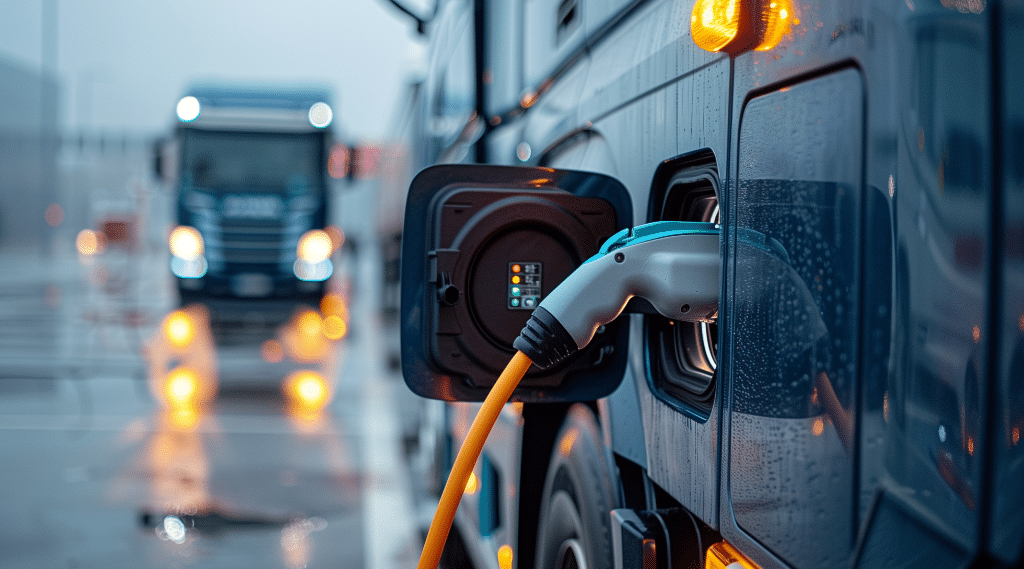“Hi, I’m Murat, and I oversee all cybersecurity aspects of fleet EV charging solutions for Electrada.”
Quite an introduction, right? I can’t tell you how many times I’ve started a meeting with that line, only to be met with raised eyebrows and a silent, unspoken question:
“Wait… why does EV charging need cybersecurity?”
After all, plugging in an electric vehicle seems like the simplest thing ever—though, don’t say that to the engineers who spend nights thinking about how an improperly designed parking spot can damage your charging cable. So, why would someone like me spend days obsessing over risks, threats, and vulnerabilities in EV charging infrastructure?
Not Just Public Charging: Why Fleet Charging Needs Cybersecurity
If we’re talking about public charging, the need for cybersecurity is obvious—even on a surface level, there’s payment data involved, which means sensitive information that naturally attracts people with questionable motivations.
But what about fleet charging (a.k.a. depot charging), where chargers often don’t require payment at the point of use—no credit cards, no on-the-spot transactions, just pre-arranged contracts handled before the infrastructure is even deployed?
At first glance, it might seem like there are few data confidentiality concerns—no payment data, no financial transactions… so, no problem, right? Well, not so fast.
Let me introduce you to the other members of the CIA triad—a fundamental cybersecurity principle that extends beyond data protection. It stands for Confidentiality, Integrity, and Availability, and it’s the last one—Availability—that makes all the difference in Fleet Charging.

Disrupting availability doesn’t require stealing data or money—it just takes one well-timed attack to prevent vehicles from charging. In cybersecurity and fleet EV charging, availability means operational survival. Imagine a fleet that relies on charging overnight to be ready for morning dispatch. If the charging system is suddenly rendered unavailable—whether due to ransomware locking up the interface, a remote access vulnerability being exploited, or a misconfigured update causing widespread failures—the impact is immediate. Trucks don’t roll. Deliveries don’t happen. The business grinds to a halt—not because data was lost, but because the fuel (in this case, electricity) couldn’t be delivered. That’s the unique challenge of fleet electrification: uptime is no longer just an IT metric; it’s a business necessity.
Progress with a Price
For years, one of the biggest barriers to EV adoption was charger reliability. If bad actors wanted to disrupt a fleet’s operations, all they had to do was wait for chargers to break down naturally, leaving vehicles unable to perform business functions.
But things are changing.
- First, according to industry resources such as Ford Authority and Kiosk Marketplace, charger reliability improved significantly in 2024.
- Second, there are players in the market, specifically Electrada—the one that I am proud to work for—that already offer solutions capable of providing contractually guaranteed 99%+ service uptime.
- Finally, fleet charging infrastructure has evolved. We’re no longer talking about a handful of chargers in a depot. We now have microgrids and local energy management systems, Vehicle-to-Grid (V2G) solutions, integration of renewable energy sources, and the list goes on.
And here is THE problem.
Something my colleagues and I have noticed: In the race to create seamless charging experience, some OEMs may have deprioritized cybersecurity, stepping away from the “secure by design” principle, forfeiting the requirement to keep cybersecurity integrated into each step of the system development lifecycle.

Some of the things my team observes quite often:
- Security trade-offs for reliability – Some security features are intentionally weakened to prevent charging disruptions.
- Hardcoded credentials & weak authentication – Because remote access needs to be fast, sometimes at the expense of being secure.
- Unpatched vulnerabilities – Because “if it works, don’t touch it.”
On top of that, the complexity of charging infrastructure has grown—sometimes to the point where we forget the goal—the vehicle needs to be charged, so it can get on the road tomorrow to continue delivering services and goods. With so many new, interconnected systems delivering electric fuel, teams are forced to think about all the risks, threats, and vulnerabilities that come with them.
Think about it: Fleet operators aren’t just small businesses with a few trucks—they’re massive, international corporations moving billions of dollars in goods and services. And while cybercriminals may not care about EV charging infrastructure itself, they do care about the disruption it can cause.
For an attacker looking to wreak havoc on supply chains, cripple logistics, or make a statement, the charging network isn’t the end goal—it’s the perfect weak link to exploit. Instead of waiting for chargers to fail on their own, bad actors now have the perfect entry points to make them fail—whether for profit, protest, or just because they can.

Cybersecurity Risks Aren’t Just an EV Problem
Let’s be clear—cybersecurity risks aren’t exclusive to EVs. They exist anywhere technology and human reliance intersect. The real issue isn’t whether EV adoption introduces new risks, but what happens when we ignore cybersecurity in the infrastructure that supports them.
For example, take the Colonial Pipeline ransomware attack. A single cyber incident caused fuel shortages across the East Coast, crippling supply chains overnight. Not because transporting fuel through pipelines is flawed, but because a key piece of infrastructure lacked proper security measures—and when that system failed, everything downstream felt the impact.
Fleet electrification is no different. As EV charging networks become an essential part of logistics and supply chains, they’re also becoming an attractive target—not just for profit-driven cybercriminals, but also for attackers looking to cause widespread disruption. The more we depend on these systems, the greater the fallout when they’re compromised.
The good news? The industry isn’t ignoring these risks. We’re seeing a shift from reactive security (“patch it when it breaks”) to proactive security (“build it right from the start”). But to truly secure cybersecurity and fleet EV charging systems, cybersecurity must be treated as a core design requirement—not an afterthought.
Because security isn’t just about stopping bad actors from stealing data; from where I stand, it’s just as much about keeping operations running smoothly. So, next time you hear “EV charging” and “cybersecurity” in the same sentence, know that it’s not just about protecting data—it’s about ensuring that the world keeps moving, one charged vehicle at a time.
What’s your take? What challenges or opportunities do you see shaping the future of cybersecurity and fleet EV charging? We’d love to hear from you so please get in touch.



